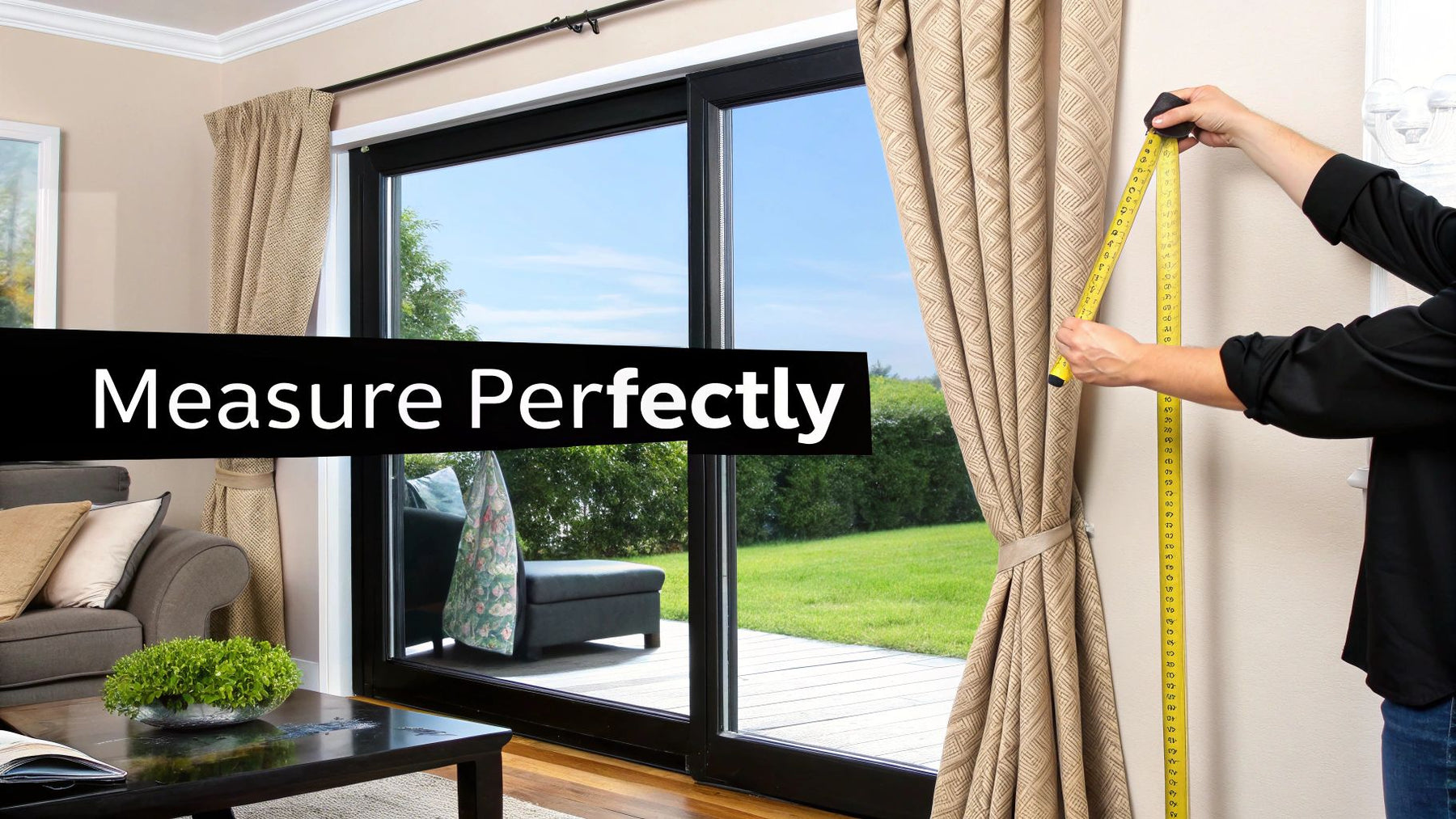
How to Measure for Curtains: A Step-by-Step Guide for a Perfect Fit
The difference between stunning, room-defining curtains and a window treatment that just looks… off… often comes down to a few inches. Getting it right can feel daunting, but this guide will demystify how to measure window curtains so you get a perfect, professional look on the first try.
What's the most important rule? Always measure the width of the curtain rod, not the window frame itself. The length you choose, however, is all about the style you’re aiming for.
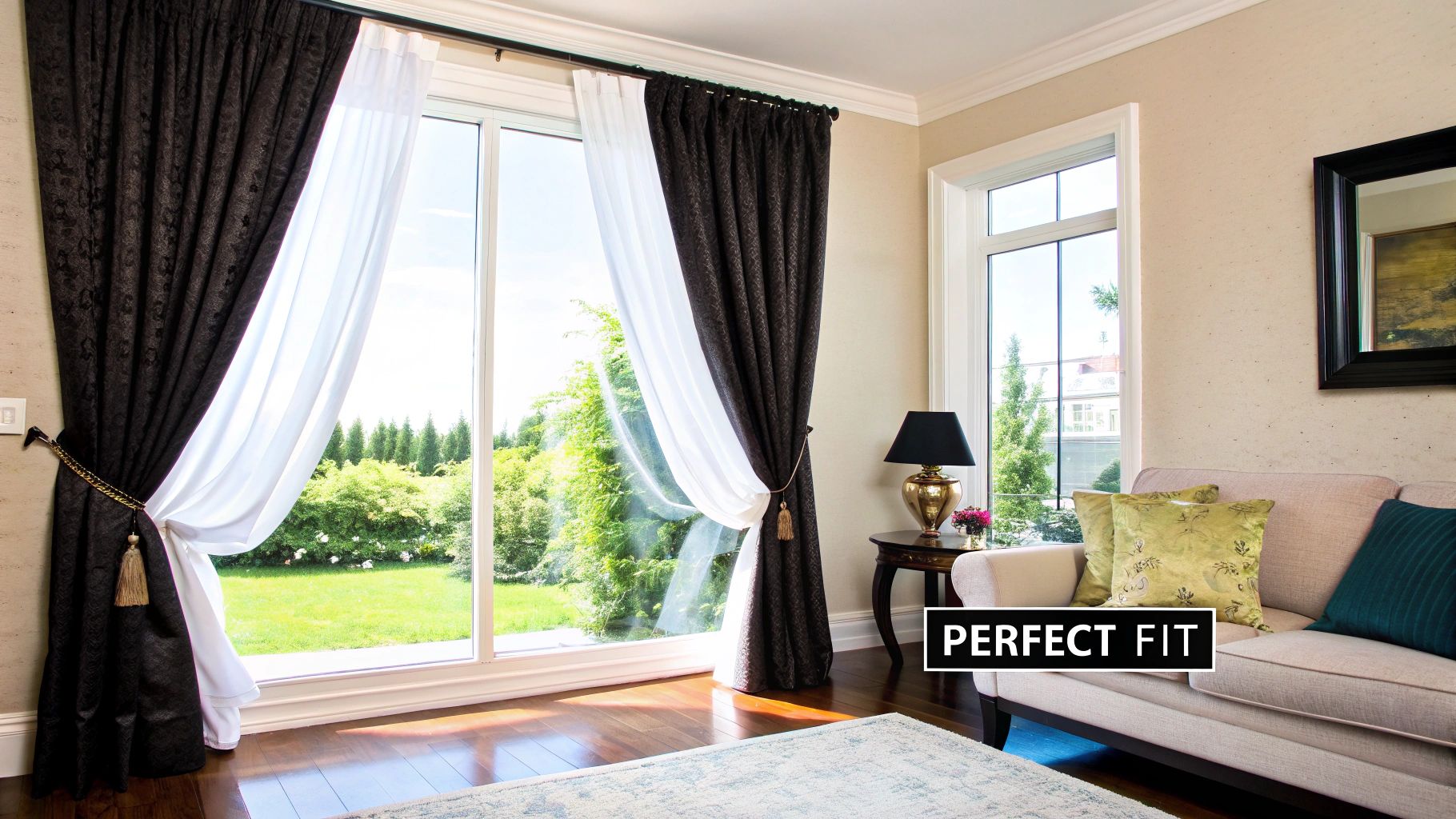
Table of Contents
- Why Nailing Your Measurements Is a Big Deal
- Step 1: Gather Your Essential Measuring Tools
- Step 2: Measure Curtain Width for Proper Fullness
- Step 3: Choose the Right Curtain Length for Any Style
- Common Measuring Mistakes to Avoid
- Frequently Asked Questions (FAQ)
Why Nailing Your Measurements Is a Big Deal
Getting your curtain measurements right is the absolute foundation of a professional-looking window treatment. We’re not just covering glass here; we're framing a view to elevate the entire room. Those precise numbers separate a custom, high-end feel from a droopy, ill-fitting mess that can make a space feel smaller and less polished.
The secret is a simple shift in perspective—stop thinking about measuring the window and start planning for the hardware. This one change transforms the process from a frustrating guessing game into a straightforward plan.
Once you understand these core concepts, you’ll feel much more confident:
- Width and Fullness: This determines how lush and gathered your curtains look. Skimping on fabric makes them look thin and cheap, but the right amount creates elegant, flowing folds.
- Length and Style: A curtain’s length instantly sets the tone. It can create a casual sill-length look in a kitchen or a dramatic, floor-puddling effect in a formal dining room.
- Rod Placement: Where you hang the rod is everything. Mounting it higher and wider than the window frame is a classic designer trick to create the illusion of a larger window and taller ceilings.
By mastering these three elements, you take full control of the final look. It's how you ensure your new gorgeous curtains hang exactly as you envisioned them.
Step 1: Gather Your Essential Measuring Tools
Before you even think about buying curtains, let’s gather your tools. Accurate measurements start with the right gear. Think of this as your prep work—skipping it is a surefire way to get frustrating, inaccurate numbers.
First and foremost, you need a rigid metal tape measure. I can't stress this enough. A soft, fabric measuring tape can easily sag or stretch over a long window, which is the number one reason people end up with curtains that are too short or long.
Next, grab a notepad and pencil, or just use the notes app on your phone. Write down your numbers the second you get them. A sturdy step stool or ladder is also a must-have for safely reaching the tops of your windows.
With these simple tools, you're setting yourself up for a smooth process and perfect results.
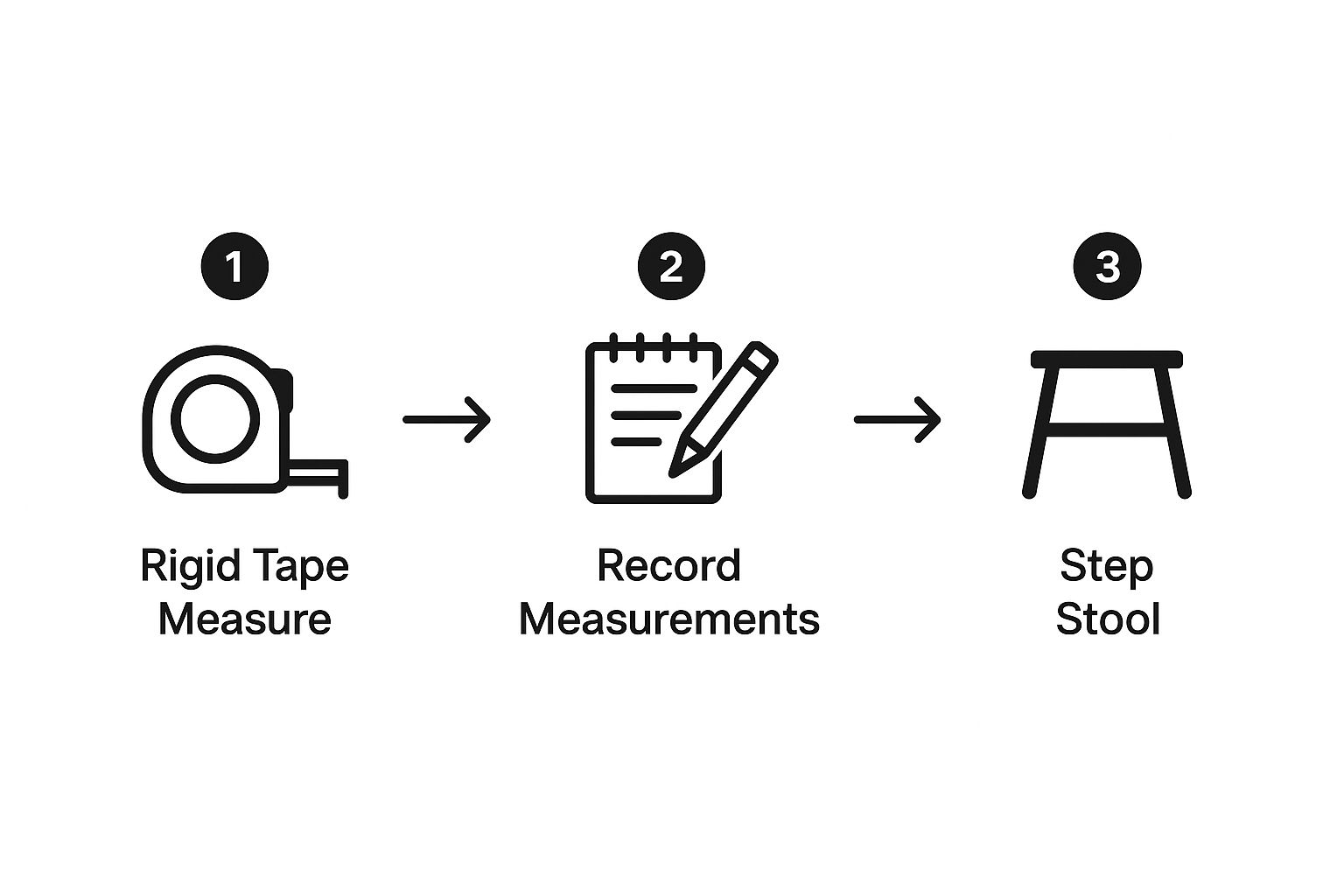
This graphic drives home the point: accuracy starts with the right equipment. If you find yourself needing to switch between units, a handy feet to inches conversion tool can be a lifesaver.
Once you’ve got your measurements triple-checked, the next step is installation. Be sure to check out our guide on how to hang curtains properly to nail that part of the process.
Step 2: Measure Curtain Width for Proper Fullness
Getting the width right is what gives your curtains that beautiful, gathered look. The secret isn't measuring the window frame itself. Instead, you'll want to measure the width of your curtain rod from end to end, excluding the decorative finials. That number is your starting point.
If you haven't installed a rod yet, here’s an expert tip: plan for it to extend 3 to 6 inches past the window frame on each side. This extra space is what designers call "stack back." It gives your open curtains a place to rest on the wall instead of bunching up and blocking natural light.
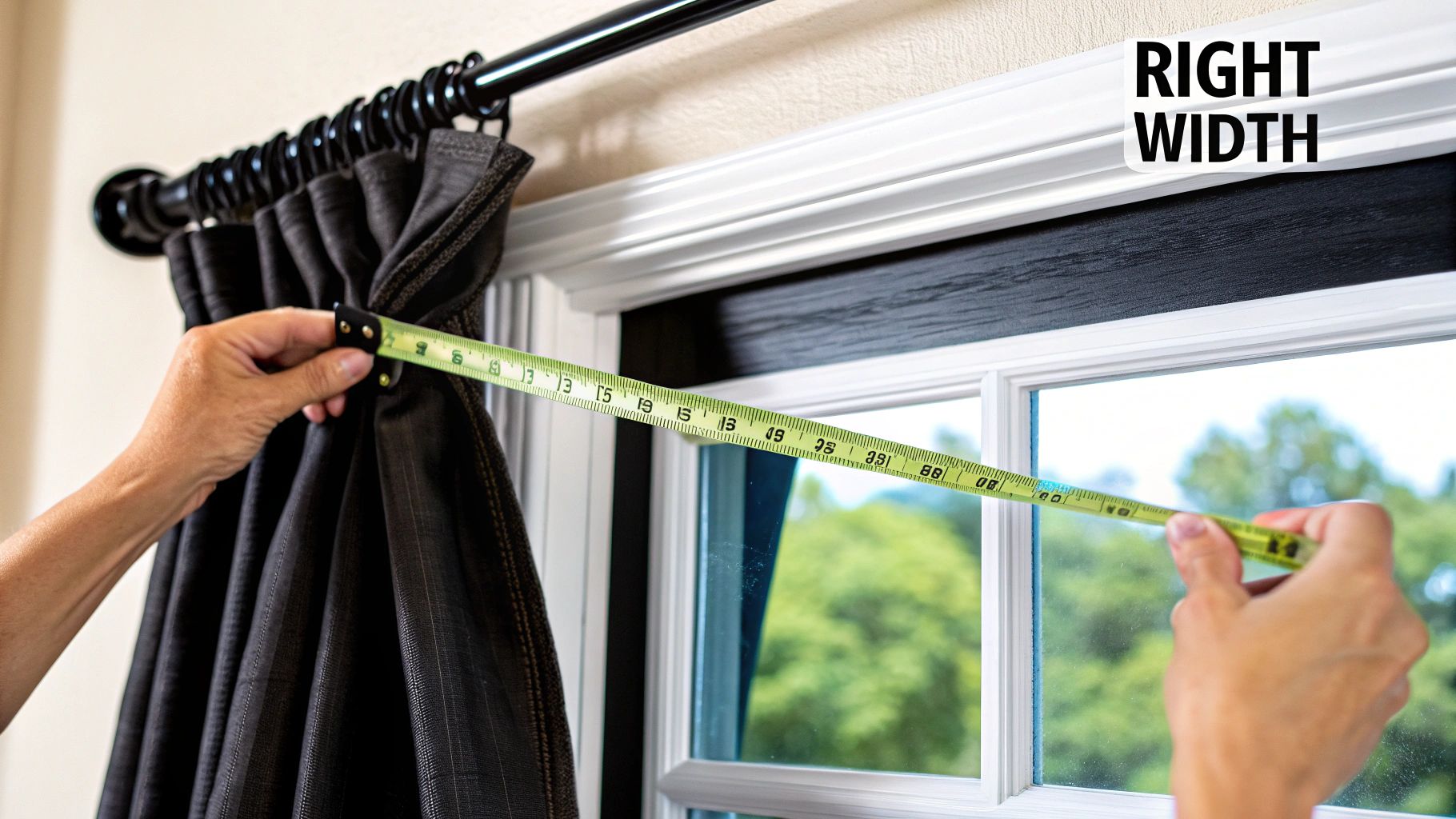
Calculating Your Fullness Factor
Once you have your rod’s width, it’s time to calculate fullness. This simple multiplication step is what stops your curtains from looking like a sad, flat sheet stretched across the window. When done right, you get classic, elegant folds.
Here’s the easy formula to follow:
- For a standard, classic look: Multiply your rod width by 1.5 to 2.
- For a rich, opulent feel: Multiply your rod width by 2.5 to 3.
For example, if your curtain rod is 48 inches wide, you’d need curtain panels with a combined width of at least 72 inches (48 x 1.5) for a tailored look. For a more dramatic vibe, you’d want up to 144 inches (48 x 3) of fabric. This simple math ensures your curtains look intentional and professionally styled.
To make this even easier, you can use our simple curtain width calculator to get the numbers perfect every time.
Why Fullness Matters So Much
Choosing the right fabric width isn’t just about aesthetics; it impacts your home's comfort and energy efficiency. It's a big reason why the global market for curtains and blinds is so massive.
The market for these window treatments was valued at around $44.31 billion in 2025 and is expected to keep growing. This reflects a major consumer shift toward home design that is both stylish and functional. You can discover more insights about global curtain trends at Accio.com.
Properly full curtains offer better insulation, helping keep rooms warmer in winter and cooler in summer. They also do a superior job of blocking light and providing privacy. Skimping on width is a common mistake, but now you know exactly how to avoid it.
Step 3: Choose the Right Curtain Length for Any Style
Curtain length is where you truly define a room's mood. It’s the difference between a casual kitchen and a formal dining room. Before you measure, have a clear vision for the style you want to achieve.
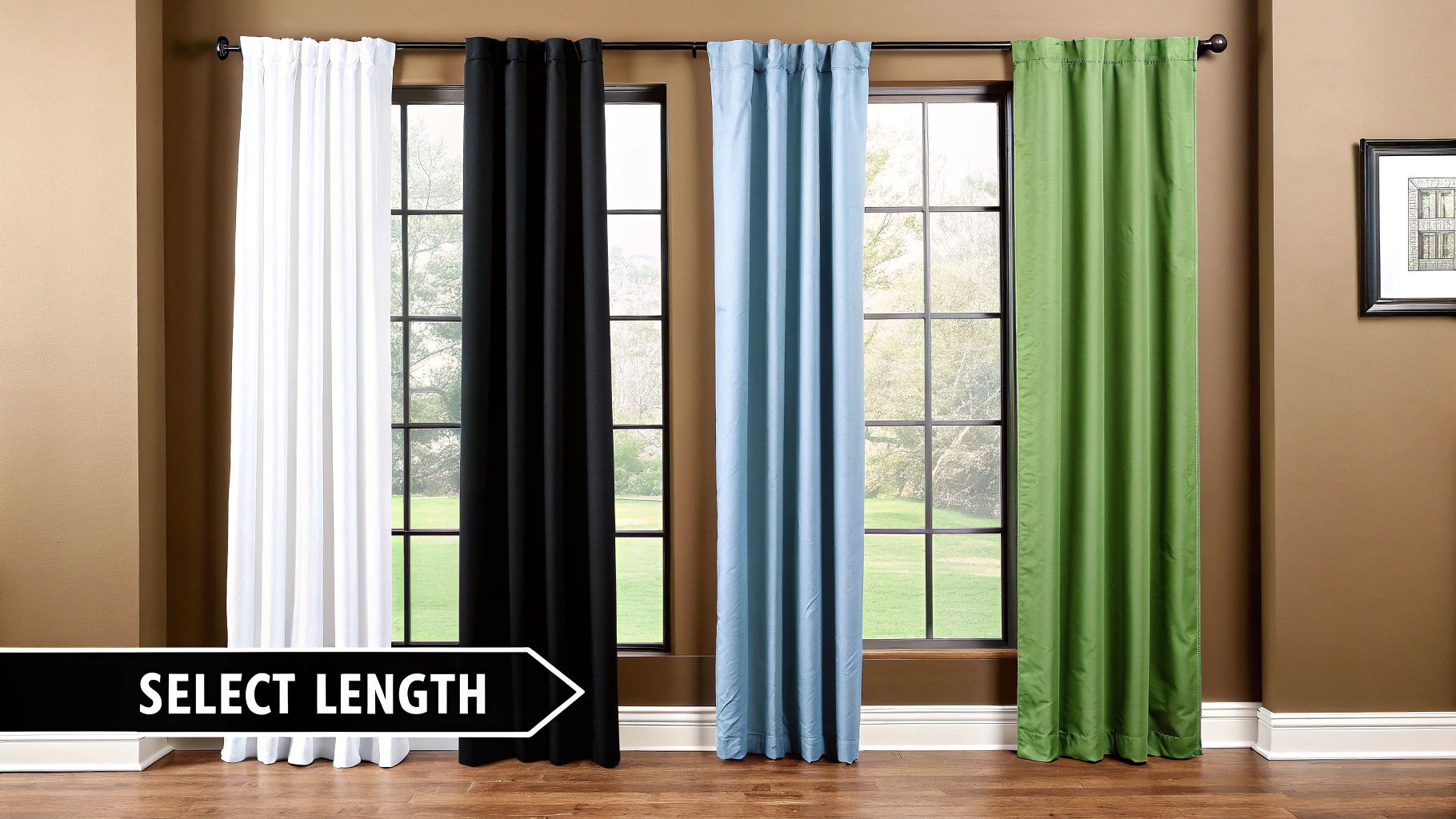
This decision is increasingly important as homeowners look for decor that's both beautiful and functional. The global window curtains market, valued around $15 billion in 2025, is projected to grow significantly, largely because consumers want more personalized and energy-efficient home solutions.
This trend makes it clear: choosing the right length isn't just about looks; it's about performance.
Four Popular Curtain Lengths
Let's walk through the four most common styles. No matter which you choose, the starting point is always the same: measure from your curtain rod down to where you want the fabric to end.
- Sill Length: The curtain ends right at the windowsill. This creates a crisp, informal look perfect for kitchens or bathrooms where long drapes would be impractical.
- Apron Length: This style extends about 4 inches below the sill, offering a more tailored appearance than sill length. It’s a great choice for windows over radiators or furniture.
- Floor Length: The most popular option, where curtains just graze or "kiss" the floor. It’s a classic, polished look that visually heightens the room. Precision here is key for effective blackout or thermal curtains.
- Puddle Length: For a dramatic, romantic statement, add an extra 1 to 3 inches to your floor-length measurement. The fabric "puddles" elegantly on the floor, creating a luxurious feel that works best in formal spaces.
A quick tip from our experience: If you're torn between floor and puddle length, consider foot traffic. Puddled curtains can collect dust and be a tripping hazard in busy areas, but they look stunning in a low-traffic formal living room.
For a deeper dive, check out our complete guide to curtain lengths to help you find the perfect fit for your space.
Common Measuring Mistakes to Avoid
Over the years, I’ve seen the same frustrating mistakes trip people up time and again when they measure window curtains. It’s heartbreaking to see someone excited about new curtains, only to realize they don't fit.
With a little foresight, you can sidestep these common pitfalls. Let's make sure that doesn't happen to you.
The single most frequent error? Measuring the window pane itself instead of the curtain rod. This almost always results in curtains that are too small, leaving awkward gaps. Remember, you're dressing the hardware, not just the glass.
Another simple but costly mistake is forgetting to double-check your numbers before clicking "buy." A quick second measurement is your best insurance policy; it’s a two-minute task that can save you the headache of returns. Trust me on this one.
Don't Overlook Obstructions and Details
It’s easy to focus so much on the window that you forget about what's around it. Before you commit to a certain length, scan the area below and around the window.
- Radiators and Vents: Are there any heating elements that floor-length drapes might cover? This isn't just about looks—it can be a fire hazard or block airflow.
- Bulky Furniture: Will that comfy sofa or bookshelf get in the way of how your curtains hang?
- Doorways: Make sure long drapes won't get caught in a nearby door every time it opens.
One of the most common ordering slip-ups is confusing a single panel with a pair. Always confirm whether the price is for one curtain or two. It’s a small detail that makes a huge difference when your package arrives.
Finally, think about how your choices impact home efficiency. The demand for precise window treatments is surging for their role in insulation. The closely related global window blinds market is projected to hit $119.2 billion by 2032, driven by the need for better light control and energy savings. You can read the full research about window treatment market growth to understand the trend.
Frequently Asked Questions (FAQ)
Getting the details right is what separates a good-looking window from a truly stunning one. Here are some of the most common questions we get about how to measure for curtains.
How high above the window should I hang my curtain rod?
The short answer is 4 to 6 inches above the window frame.
This is a classic designer trick that creates an illusion of height, making your ceilings feel taller and the room seem more open. If you have very high ceilings, you can even go halfway between the top of the window and the ceiling. Avoid mounting the rod directly on the frame, as this tends to make the window look smaller.
Should my curtains touch the floor?
This depends on your desired style. For a crisp, modern feel, have your curtains "kiss" the floor (hanging about a half-inch above it). For a more traditional look, they can just graze the floor.
If you're aiming for a romantic or relaxed vibe, letting them "puddle" is the way to go. Just add an extra 1 to 3 inches of fabric so it pools elegantly. The only look to sidestep is the "high-water" style where the curtains end awkwardly several inches too high.
Insider Tip: The "kiss" length is beautiful but demands absolute precision. If your floors aren't perfectly even, a puddle length is much more forgiving and stylishly hides imperfections.
What is "stack back" and why is it important?
Stack back is the amount of space your curtains take up on the sides of the window when they're fully open. It’s a crucial detail for maximizing natural light.
To account for stack back, extend your curtain rod 3 to 6 inches past the window frame on each side. This gives the fabric a place to rest on the wall instead of covering the glass, keeping your view clear and letting the maximum amount of sunlight pour in.
Ready to put those perfect measurements to work? Joey'z Shopping has a gorgeous collection of high-quality curtains to bring your vision to life. Find your perfect style today!
